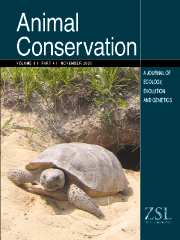Crossref Citations
This article has been cited by the following publications. This list is generated based on data provided by
Crossref.
Ancrenaz, Marc
Gimenez, Olivier
Ambu, Laurentius
Ancrenaz, Karine
Andau, Patrick
Goossens, Benoît
Payne, John
Sawang, Azri
Tuuga, Augustine
Lackman-Ancrenaz, Isabelle
and
Mace, Georgina M.
2004.
Aerial Surveys Give New Estimates for Orangutans in Sabah, Malaysia.
PLoS Biology,
Vol. 3,
Issue. 1,
p.
e3.
GOOSSENS, B.
CHIKHI, L.
JALIL, M. F.
ANCRENAZ, M.
LACKMAN‐ANCRENAZ, I.
MOHAMED, M.
ANDAU, P.
and
BRUFORD, M. W.
2005.
Patterns of genetic diversity and migration in increasingly fragmented and declining orang‐utan (Pongo pygmaeus) populations from Sabah, Malaysia.
Molecular Ecology,
Vol. 14,
Issue. 2,
p.
441.
KANAMORI, Tomoko
and
KUZE, Noko
2006.
The Study Area of Wild Orangutans at Danum Valley Conservation Area, Borneo.
Primate Research,
Vol. 22,
Issue. 1,
p.
51.
Goossens, Benoît
Chikhi, Lounès
Ancrenaz, Marc
Lackman-Ancrenaz, Isabelle
Andau, Patrick
Bruford, Michael W
and
Mace, Georgina
2006.
Genetic Signature of Anthropogenic Population Collapse in Orang-utans.
PLoS Biology,
Vol. 4,
Issue. 2,
p.
e25.
Marshall, Andrew J.
Nardiyono
Engström, Linda M.
Pamungkas, Bhayu
Palapa, Jhon
Meijaard, Erik
and
Stanley, Scott A.
2006.
The blowgun is mightier than the chainsaw in determining population density of Bornean orangutans (Pongo pygmaeus morio) in the forests of East Kalimantan.
Biological Conservation,
Vol. 129,
Issue. 4,
p.
566.
GOOSSENS, B.
SETCHELL, J. M.
JAMES, S. S.
FUNK, S. M.
CHIKHI, L.
ABULANI, A.
ANCRENAZ, M.
LACKMAN‐ANCRENAZ, I.
and
BRUFORD, M. W.
2006.
Philopatry and reproductive success in Bornean orang‐utans (Pongo pygmaeus).
Molecular Ecology,
Vol. 15,
Issue. 9,
p.
2577.
JALIL, M. F.
CABLE, J.
SINYOR, J.
LACKMAN‐ANCRENAZ, I.
ANCRENAZ, M.
BRUFORD, M. W.
and
GOOSSENS, B.
2008.
Riverine effects on mitochondrial structure of Bornean orang‐utans (Pongo pygmaeus) at two spatial scales.
Molecular Ecology,
Vol. 17,
Issue. 12,
p.
2898.
Mathewson, P. D.
Spehar, S. N.
Meijaard, E.
Nardiyono
Purnomo
Sasmirul, A.
Sudiyanto
Oman
Sulhnudin
Jasary
Jumali
and
Marshall, A. J.
2008.
EVALUATING ORANGUTAN CENSUS TECHNIQUES USING NEST DECAY RATES: IMPLICATIONS FOR POPULATION ESTIMATES.
Ecological Applications,
Vol. 18,
Issue. 1,
p.
208.
Marshall, Andrew J.
and
Meijaard, Erik
2009.
Orang-utan nest surveys: the devil is in the details.
Oryx,
Vol. 43,
Issue. 03,
p.
416.
Danilewicz, Daniel
Moreno, Ignacio B.
Ott, Paulo H.
Tavares, Maurício
Azevedo, Alexandre F.
Secchi, Eduardo R.
and
Andriolo, Artur
2010.
Abundance estimate for a threatened population of franciscana dolphins in southern coastal Brazil: uncertainties and management implications.
Journal of the Marine Biological Association of the United Kingdom,
Vol. 90,
Issue. 8,
p.
1649.
Meijaard, Erik
Albar, Guillaume
Nardiyono
Rayadin, Yaya
Ancrenaz, Marc
Spehar, Stephanie
and
Gratwicke, Brian
2010.
Unexpected Ecological Resilience in Bornean Orangutans and Implications for Pulp and Paper Plantation Management.
PLoS ONE,
Vol. 5,
Issue. 9,
p.
e12813.
Kanamori, Tomoko
Kuze, Noko
Bernard, Henry
Malim, Titol P.
and
Kohshima, Shiro
2010.
Feeding ecology of Bornean orangutans (Pongo pygmaeus morio) in Danum Valley, Sabah, Malaysia: a 3‐year record including two mast fruitings.
American Journal of Primatology,
Vol. 72,
Issue. 9,
p.
820.
Ancrenaz, Marc
Ambu, Laurentius
Sunjoto, Indra
Ahmad, Eddie
Manokaran, Kennesh
Meijaard, Erik
Lackman, Isabelle
and
Chave, Jerome
2010.
Recent Surveys in the Forests of Ulu Segama Malua, Sabah, Malaysia, Show That Orang-utans (P. p. morio) Can Be Maintained in Slightly Logged Forests.
PLoS ONE,
Vol. 5,
Issue. 7,
p.
e11510.
Meijaard, Erik
Mengersen, Kerrie
Buchori, Damayanti
Nurcahyo, Anton
Ancrenaz, Marc
Wich, Serge
Atmoko, Sri Suci Utami
Tjiu, Albertus
Prasetyo, Didik
Nardiyono
Hadiprakarsa, Yokyok
Christy, Lenny
Wells, Jessie
Albar, Guillaume
Marshall, Andrew J.
and
Turvey, Samuel
2011.
Why Don't We Ask? A Complementary Method for Assessing the Status of Great Apes.
PLoS ONE,
Vol. 6,
Issue. 3,
p.
e18008.
Ross, Caroline
and
Reeve, Nigel
2011.
Field and Laboratory Methods in Primatology.
p.
111.
Wich, Serge A.
Gaveau, David
Abram, Nicola
Ancrenaz, Marc
Baccini, Alessandro
Brend, Stephen
Curran, Lisa
Delgado, Roberto A.
Erman, Andi
Fredriksson, Gabriella M.
Goossens, Benoit
Husson, Simon J.
Lackman, Isabelle
Marshall, Andrew J.
Naomi, Anita
Molidena, Elis
Nardiyono
Nurcahyo, Anton
Odom, Kisar
Panda, Adventus
Purnomo
Rafiastanto, Andjar
Ratnasari, Dessy
Santana, Adi H.
Sapari, Imam
van Schaik, Carel P.
Sihite, Jamartin
Spehar, Stephanie
Santoso, Eddy
Suyoko, Amat
Tiju, Albertus
Usher, Graham
Atmoko, Sri Suci Utami
Willems, Erik P.
Meijaard, Erik
and
Gursky-Doyen, Sharon
2012.
Understanding the Impacts of Land-Use Policies on a Threatened Species: Is There a Future for the Bornean Orang-utan?.
PLoS ONE,
Vol. 7,
Issue. 11,
p.
e49142.
Samejima, Hiromitsu
Ong, Robert
Lagan, Peter
and
Kitayama, Kanehiro
2012.
Camera-trapping rates of mammals and birds in a Bornean tropical rainforest under sustainable forest management.
Forest Ecology and Management,
Vol. 270,
Issue. ,
p.
248.
Sharma, Reeta
Arora, Natasha
Goossens, Benoit
Nater, Alexander
Morf, Nadja
Salmona, Jordi
Bruford, Michael W.
Van Schaik, Carel P.
Krützen, Michael
Chikhi, Lounès
and
Getz, Wayne M.
2012.
Effective Population Size Dynamics and the Demographic Collapse of Bornean Orang-Utans.
PLoS ONE,
Vol. 7,
Issue. 11,
p.
e49429.
Meijaard, Erik
Wich, Serge
Ancrenaz, Marc
and
Marshall, Andrew J.
2012.
Not by science alone: why orangutan conservationists must think outside the box.
Annals of the New York Academy of Sciences,
Vol. 1249,
Issue. 1,
p.
29.
Santosa, Y
and
Rahman, D A
2012.
Evaluation of the Precision of Nest Method to Estimate Orangutan Population and Determination of Important Ecological Factors for Management of Conservation Forest.
Jurnal Manajemen Hutan Tropika (Journal of Tropical Forest Management),
Vol. 18,
Issue. 1,
p.
39.


